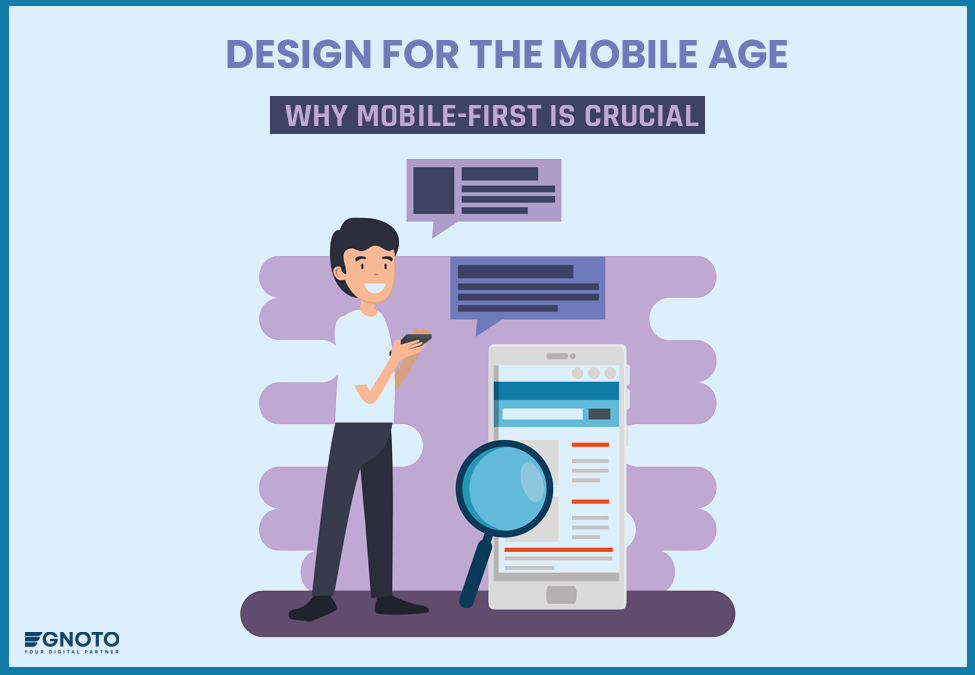Why do you use a mobile phone to talk to friends and family, find jobs, order food, watch movies, find answers to doubts, and study? We know your answer! It’s “For everything.” Like you, billions of people move to their phones first whenever they need to see or find anything. They access various websites and applications more through mobile devices than desktops, which expedited the need for mobile-first designs.
People use their mobile devices around 150 times a day; 60% of traffic comes from mobile devices, 55% of website traffic comes from smartphones, and 9 out of 10 internet users access the internet through mobile devices. The data about smartphone usage is immense because this small device in people’s pockets controls a major part of their lives.
So, if you plan to build a website or application, consider a mobile-first strategy, as it will affect your user experience. Our blog provides a deep dive into the reasons for adopting mobile-first designs.
What Is Mobile-first Design?
Mobile-first designs mean you start developing an app or website with mobile in mind, not desktop. It means prototyping the design for the smallest screen first and then scaling it up. The priority is given to mobile users for the best user experience by designing features and functionality of the app for mobile screens.
This approach is helpful as designing for a small screen and then leveling up for the larger screen is easy. However, designing for a large screen and trying to fit designs and content on a small screen like a smartphone takes a lot of work. This happens due to the space variations on the screen, which provide limited space to show content.
When you open a website or app on a mobile phone, the designs and features often look dissimilar and unorganized. A mobile-first design approach resolves this issue so users can enjoy seamless experiences regardless of the types and sizes of devices.
Difference Between Mobile-first and Mobile-friendly Designs?
People often get confused between mobile-first and mobile-friendly designs. They think both are the same, but they aren’t.
Mobile-first designs – Apps or websites are first built for small screens and gradually adapt to larger screens.
Phone > Tablet > Laptop > Desktop
Mobile-friendly designs – Apps or websites are first built for larger screens, such as Desktops, and gradually adapt to small screens, such as mobile devices.
Desktop > Laptop > Tablet > Phone
All mobile-first designs are mobile-friendly, but not all mobile-friendly designs.
Why Prioritizing Mobile-First Design Is Crucial Now?
If you plan to build a website in 2025, you must assess whether it needs a mobile-first strategy. In the space below, check out how this approach benefits your product.
- Rising Mobile Usage:
We all know how significant this small device is in our lives. From browsing to shopping to accessing information, people pick up their phones before starting to think about anything. When mobile phones are taking over the world, traffic on your app or site can be affected if you stick to the old method. So, rising mobile usage is one of the biggest reasons for adopting a mobile-first approach.
The image below shows the total number of mobile users worldwide from 2014 to 2029. As you can see, the number was forecast to increase consistently, which clearly indicates that more people will use mobiles for more hours in the future.
- Enhanced Performance:
When developers take a mobile-friendly approach, they focus on essential features and streamline content for mobile users. This approach minimizes page load time, which is crucial for a better user experience. Often, visitors leave a website if the page doesn’t load in 3 seconds. Mobile-friendly websites load faster and reduce users’ wait time.
Yes, internet speed does affect page load time. But if a page is not designed correctly, it can still take a long time to load. Mobile-first approach cuts the crap and directs users straight to the exact content without any clutter.
This approach allows developers to reduce file size and minimize HTTP requests, which is favorable for building clean websites. It leads to faster loading times and enhanced performance.
- Improved Customer Satisfaction:
Nowadays, customer expectations are higher than they used to be. One reason is fierce competition among businesses to provide the best to their customers. People want seamless mobile-optimized experiences when they visit any website or application. Google also prioritizes customer satisfaction. If your website is not performing well, it can affect its ranking in SERPs.
The mobile-first approach improves customer satisfaction by allowing developers to focus on essential features because it directly affects users’ experiences. With the mobile-first strategy, developers can build more intuitive and mobile-friendly designs. It makes navigation easy so that users can find products or services on the site half the time without waiting and confusion.
So, design plays a crucial role in website development, as more than 90% of first impressions of a website are related to it.
- Faster Page Load Times:
An average site takes around 8 seconds to load, but 83% of website visitors want it to load in 3 seconds to load. A mobile-first strategy allows developers to optimize resources for fast loading. They focus on loading only essential HTTP requests, reducing the crap and speeding the process. Since you are designing for small screens, you use compressed-size images, files, and responsive designs, which helps with faster page load.
Overall, the mobile-first design reduces payload and minimizes initial load time. Pages that take more than 5 seconds to load have around a 38% bounce rate. And, you understand that a higher bounce rate is not good for the website and revenue. So, a mobile-first approach not only speeds up the pages, it also scales up your revenue.
- Improved Responsiveness:
When you use mobile-friendly designs, you will not need to work on the app’s responsiveness separately because they are inherently responsive. It means your app can work flawlessly on screens of different sizes and orientations, ensuring your site looks and functions seamlessly across various devices.
Responsiveness is crucial to serving diverse customers. With this approach, developers can finish the most challenging part of development first, which is creating responsive designs. Once designing for responsiveness is done, you can focus on less complex tasks. So, as your users switch from mobile to laptop or desktop, they have a consistent, seamless experience.
- Future-proofing:
By adopting a mobile-friendly design, you can address current trends and prepare for the future. As device sizes reduce and technology evolves, the mobile-first approach will be an effective method for your application. With this strategy, your product can adapt quickly and effectively to changes.
You will not need to make a lot of changes to your website or app in the future, which will help you save time and resources. Responsive designs and faster page loads help to ensure users get a consistently improved experience today and tomorrow.
How to Build Mobile-First Designs?
When it comes to implementing mobile-first designs, the actual game starts here. We have tried simplifying it with some steps in the space below. Have a look at them.
- Everything begins with understanding the audience:
Yes, everything starts and ends with your audience. So, first, research and find out who your audience is, what they like, which devices they use, and how often. This information will help you make crucial decisions to design an app or site accordingly.
- Define clear use cases for mobile interactions:
When do users generally interact with your website? Identify the specific time when your audience visits your website or app using mobile phones instead of desktops. This way, you can streamline user flow and create features for the site accordingly. Not all content fits the screen size, so with the help of use cases, you can identify what fits and when.
- Content should be easily readable and compact:
Since mobile screens are small, it is challenging for developers to adjust all the essential features and content. As a developer, you should focus on using readable and compact content. Use clear headings, short paragraphs, and bullet points to enhance readability. Present only the main content on the app as per the layout.
- Focus on mobile-first design principles:
Here are some mobile-first design principles to help you develop a site for small screens.
- Responsive design for a seamless experience across various devices regardless of size and type.
- Better UX for impressive and intuitive designs. It helps with easy navigation for an improved user experience.
- Test your app on real devices to check for flaws. Compare how your site looks in your imagination to how it actually looks on real devices.
- Focus on the content hierarchy to show what is crucial for users. Analyzing user behavior and flows on your site will help you determine this.
- We all know devices heavily rely on touch-based interactions, so ensure you develop touch-friendly interfaces. Analyze what should be the exact location of buttons and links on the site.
Wrapping Up
So, yes, Mobile-first design matters. It is not only the need of the hour but also essential for the future. Since billions of people spend most of their lives on mobile devices to find answers to every question, this approach is crucial to developing a full-fledged and responsive app and website. You can offer improved customer experiences to your audience with the help of a mobile-first strategy. Moreover, this trend is also effective for future development approaches because of increasing customer demand for improved services and reducing the size of devices.
However, developing this type of app can be difficult initially, but it gets easier gradually. Follow the steps to build mobile-first designs and principles.
So, are you ready to put the best foot forward with a mobile-first strategy? Egnoto can help you shape your online presence with the help of dedicated developers.










